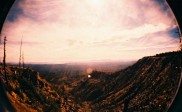Action Photography Techniques
Action Photography is an interesting form of photography. The possibility of freezing the movement of a fast subject is one of the most incredible aspects of photography.
Shutter speed, the position of the camera, the angle of view, moving the camera in concordance with the subject, etc; all of these procedures and techniques determine the way the action and movement are portrayed in the photograph. Action photography encompasses all the aspects of motion, from the power of a racing car to the harmonious rhythm of a dance.
In action photography, shutter speed is one of the most important elements that contribute to the success of the photo. In a condition with good lighting you can use a shutter speed that is fast enough to freeze movements that are indiscernible to the human eye. With the proper equipment you will be able to maintain such shutter speeds even in low light conditions. But setting the appropriate speed isn’t enough to get a successful action photo. You will have to deal with a rapid succession of events and having a solid knowledge of photographic techniques can make it easier for you to get great action shots. Generally you will have little to no time to set the exposure, focus on your subject and compose the image. Thus, you need to choose in advance your shutter speed and your point of view. Other techniques, such as, pre-focusing and panning will assure you get great photos. Chance and luck have only minor roles in the success of an action photo. Preparation and the mastery of different techniques, on the contrary, play a very crucial role.
Shutter Speed:
Freezing the Action:

Photo by Damian Morys Foto
If you aim to freeze action, you need to use a camera that allows for shutter speeds fast enough to capture different kinds of moving subjects. This is not really important nowadays, as most cameras have shutter speeds that go up to 1/4000s which can handle most of the situations. What is more important is how to choose the appropriate speed and how it can affect the exposure.
You will have to set your shutter speed according to your subject’s speed and the distance that separates you from it. The further away your subject is, the slower the speed needed to freeze it. If you are trying to capture a person who is running, you will need a shutter speed that is a between 1/250s and 1/500s. In the case of photographing a car, you should consider shutter speeds between 1/500s and 1/2000s, depending on its actual speed.
Freezing action with fast shutter speeds, entails exposure times that are very short which will need to be consolidated with high ISO settings and fast lenses , in order to get correct exposures, especially in low light conditions. Fast lenses are the lenses with a very wide maximum aperture, allowing for more light to hit the sensor or the film. Fast lenses also provide a bright image in the camera’s view finder which facilitates focusing.
Motion Blur:

Photo by LijoJose
A slow shutter speed easily suggests movement by creating a motion blur of the moving subject. To get this effect, you generally need shutter speeds that are slower than 1/60s. Experiment with different shutter speeds to see the various effects you can get with motion blur. In a composition presenting several elements with different movement speeds, with the appropriate shutter speed you can get to freeze one of those elements while having the other elements appear blurred. This can create a very interesting effect and will give more impact to the action shot. Sometimes a motion blur can render the essence of action more than the act of freezing it.
Panning:

Photo by PresleyJesus
This is another technique which is used to convey action and movement through motion blur. But in this case, it is the background that is blurred instead of the moving subject.
This is done by moving the camera during the exposure, in order to follow the movement of the subject. This technique will allow you to freeze action even when using slow shutter speeds. But, it also can come in handy even with a fast shutter speed, especially if the subject is very fast, such as racing cars, or the photographer is very close to the action.
When taking a panning shot, you need to prepare yourself beforehand.
First, find your subject’s trajectory and set your focus to the range where your subject will pass. Then frame your subject and move your upper body along with it, without moving your feet. Press the shutter release button while keeping your subject in the view finder and don’t stop your panning movement immediately after the end of the exposure to make sure you get a successful panning shot.
Try to compose your panning shot with a background presenting a mix of dark and bright spaces to get the best results. A background that is even and plain, such as a clear blue sky will give you poor results with the technique of panning.
Focusing on a Predetermined Point:
Because of rapidity of execution required by action photography, it is nearly impossible to maintain constantly a precise focus on the subject, especially with a telephoto lens.
The technique of focusing on a predetermined point comes as a solution to such problem. It consists of choosing your focus point in advance and then to wait for the subject to reach that point to take the photo. Anticipating the action and timing are very important when using this technique. You need to study the course and steps of the action in order to be able to choose the appropriate focus point. You will also have to work on making your timing perfect; take the shot a few moments before or after your subject reaches the focus point and you run the risk of your subject getting out of the focus range. But the only way to get this technique right is practice. Practice as much as possible and you will eventually get the perfect shot.
Choosing a Point of View:

Photo by Starka-Snap
Choosing the right point of view can make all the difference between a dull static image and a vivid dynamic photo captured in the heart of action.
Try to find the location that will make the viewers feel like they were there at the moment of the action. Go to the place where the action or sports event is taking place early, and move around and try to find different spots that can provide good angles for taking photos. While scouting for a location, keep in mind the background and the lighting as they are as important as the angle of view.
You may want to take a look at 30 Incredible Examples Of Sport & Action Photography.




Keep up the good work. Thanks.